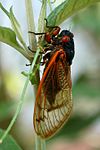 |
| Photo: Philip N. Cohen |
As Brood XIX cicadas emerge in the South, you would think that local birds would be preparing for a once-every-13-years feast. But, rather than flocking in and chowing down, bird numbers decline in regions experiencing a periodical cicada emergence. These declines have been confirmed by the annual Breeding Bird Count (BBC) that takes place across the country in May and June.
Scientists at Cornell University’s Lab of Ornithology, the University of Maryland, and the U.S. Department of Agriculture wondered whether the loud trill of the cicadas was drowning out bird calls, so BBC surveyors merely didn’t hear birds that were still there; whether something about the cicada emergence drove birds away from an area; or if birds experienced a true population decline during cicada emergence years.
In a study published in the journal Ecology, they compared various measures of bird populations in years of cicada emergence, and years without a cicada emergence. They also looked at those population measures in places where the cicadas could be heard, and in places where cicadas couldn’t be heard.
If it was just a matter of the surveyors not hearing birds among the din of the cicadas, the number of birds in the cicada areas would drop, while the number of birds in the non-cicada areas would stay the same. If the cicadas were driving the birds away, there would be fewer birds near the cicadas and more where the weren’t cicadas. Finally, if the number of birds declined similarly in areas with and without cicadas, then some other factor was at work.
The researchers used BBC data from the 1987 and 2004 emergences of Brood X, the periodical cicadas that live in the Mid Atlantic states. The data included whether or not the surveyors could hear cicadas at each data collection point.
They found that the number of birds declined similarly in areas where there were cicadas and areas where there weren’t cicadas within the Brood X emergence region. The findings strongly suggest a true decline in birds during these years.
What is causing that decline? The researchers could only speculate. But perhaps the mysterious environmental trigger that leads the cicadas to emerge every 13 years in the South, and generally every 17 years in the North, also influences the bird population decline — giving the cicadas the best chance of creating a new generation, without winding up as an avian snack.
Read the whole paper on the Cornell researcher’s Web site, here.
Read more about the current cicada emergence, here, in USA Today and on Nashville Public Radio.
Photo: Brood XIX cicada in Chapel Hill, NC, taken by Philip N. Cohen
